|
|
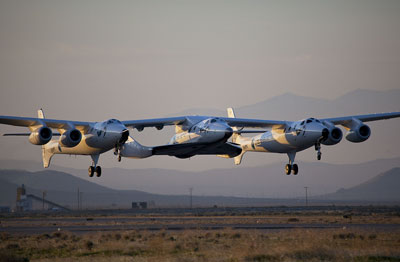 WhiteKnightTwo and SpaceShipTwo take off Monday morning from Mojave (credit: Mark Greenberg) Yesterday morning WhiteKnightTwo took off from Mojave Air and Space Port in California with a special payload attached to it: SpaceShipTwo, making its first, albeit captive carry, flight. The flight lasted two hours and 54 minutes and achieved an altitude of about 13,700 meters (45,000 feet). The flight went well, according to all accounts, and Burt Rutan said in a Virgin statement, “The captive carry flight signifies the start of what we believe will be extremely exciting and successful spaceship flight test program.”
The flight also took place roughly on schedule. As Virgin Galactic’s Stephen Attenborough said last month at the Next-Generation Suborbital Researchers Conference in Boulder, Colorado, the first captive carry test would take place by the end of the first quarter of this year (which it achieved with a little over a week to spare). Captive carry tests would continue through the second quarter with the first glide test some time in the third quarter; the first powered test flight would, he hoped, take place by the end of the year.
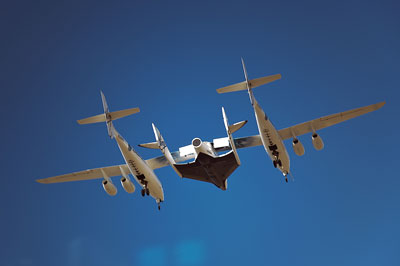 WhiteKnightTwo and SpaceShipTwo in flight (credit: Mark Greenberg) One minor thing I noted. As you can see in the picture above, SpaceShipTwo flew without an engine, or, apparently, an engine nozzle: just a black plug of some kind where the engine would go. See the closeup below:
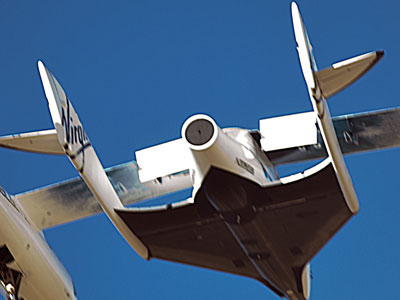
Compare that to an image I took of the vehicle during the rollout ceremony last December, when there was at least a replica engine nozzle in place:
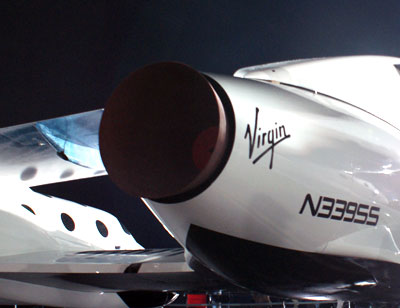
The news media has something of a case of amnesia when it comes to space tourism in Russia: they regularly, breathlessly report comments that Russia will stop flying space tourists on Soyuz flights to the ISS. Every few months, it seems, a Russian official makes comments to that regard, dutifully reported by the wire services and others. There’s a good reason why they’re not: the seats are all needed for ferrying crews to and from the ISS, particularly with the retirement of the shuttle. Also recall that Russia had made similar statements in the past only to have seats become available, as was the case with last year’s flight of Guy Laliberté. When that flight opportunity was first announced last year, Space Adventures’ Eric Anderson said he felt there still might be occasional flight opportunities even after the station goes to a six-person crew.
Virgin Galactic provided an update on their plans at a conference in Dubai this week, although the information they provided appears to be largely similar to what the company reported at a suborbital research conference in Boulder last month. Will Whitehorn did say that he didn’t believe the company didn’t need additional investment to complete development of SpaceShipTwo after Abu Dhabi’s Aabar Group invested $280 million into the company last year. Although Aabar has exclusive regional rights to SS2, Whitehorn said there were no plans for SS2 flights to take place there for the foreseeable future.
If you (or, rather, your kids) watch the Nickelodeon show “iCarly”, you might be interested in Friday’s episode, based on this description: “A quirky billionaire asks Carly and her friends to put on the first live Web show from outer space, so they undergo tests for space travel.” A billionaire who wants to send some kids into orbit to do a webcast is probably a little more than just “quirky”.
The web site Big Think has posted an extended interview with Burt Rutan, who talks about space tourism, innovation in NASA and the private sector, and other topics. I haven’t watched the full one-hour interview in its entirety yet, but in the portions I’ve watched he covers some familiar ground about the utility of space tourism and the innovation—or lack thereof—he sees at NASA today compared to the space agency of the 1960s:
If you hear him say anything interesting post it in the comments.
The entrepreneurial space industry has been big supporters—and beneficiaries—of prizes, from the Ansari X PRIZE and the Google Lunar X PRIZE to NASA’s Centennial Challenges prize program. Now it looks the latter is going to get a lot more robust. After several years of not getting any funding, Centennial Challenges got $4 million in NASA fiscal year 2010 budget. And in detailed budget documents released yesterday, Centennial Challenges, now part of the Space Technology portion of the budget would get $10 million a year in fiscal years 2011 through 2015. Here’s how NASA describes it will use the money, if Congress goes along with the budget request:
The $10 million per year FY 2011 request for Centennial Challenges will allow NASA to pursue new and more ambitious prize competitions. Topics for future challenges that are under consideration include revolutionary energy storage systems, solar and other renewable energy technologies, laser communications, demonstrating near-Earth object survey and deflection strategies, innovative approaches to improving the safety and efficiency of aviation systems including Next Generation Aeronautics efforts, closed-loop life support and other resource recycling techniques, and low-cost access to space. Annual funding for Centennial Challenges allows new prizes to be announced, addressing additional technology challenges that can benefit from the innovation of the Citizen inventor.
In addition, NASA is planning a one-day technical symposium this Thursday featuring winners of several of the recent Centennial Challenges. That will be followed Friday by a recognition ceremony for the winners, featuring NASA administrator Charles Bolden. There’s also talk that NASA will use the event to announce one or more new prizes.
Besides the developments by several vehicle operators, there have been a number of other announcements by various organizations at the Next-Generation Suborbital Researchers Conference. The biggest, in the plenary speech by NASA deputy administrator Lori Garver, is that NASA has requested $15 million for the Commercial Reusable Suborbital Research (CRuSR) program in its FY11 budget. That’s a major increase over the $2.5 million the program is getting in the current fiscal year, split among the Exploration Systems Mission Directorate (ESMD), Science Mission Directorate (SMD), and the Innovative Partnerships Program (IPP). The $15 million in the FY11 budget proposal would come entirely from IPP. In addition, Garver said the five-year budget plan funds CRuSR at the same level throughout the period (although that is subject to change from year to year.)
Other organizations are putting up money for suborbital research as well. The Southwest Research Institute (SwRI) announced it’s allocating $1 million to commercial suborbital research efforts, specifically to “build and fly experiments with SwRI payload specialists on next-generation suborbital vehicles.” This effort is led by Alan Stern, who has been one of the leading proponents of “research and education market” (REM) uses of commercial suborbital vehicles.
The Commercial Spaceflight Federation, meanwhile, is expanding its membership to include academic affiliates. Purdue University, Johns Hopkins University, Princeton University, and George Mason University are the initial four institutions affiliating themselves with the CSF, a NewSpace industry organization.
In yesterday’s sessions at the Next-Generation Suborbital Researchers Conference in Boulder, Colorado, four major developers of suborbital vehicles presented updates on their efforts. Here’s a summary of what they revealed:
Virgin Galactic: Stephen Attenborough provided considerable details about their plans to flight test SpaceShipTwo (SS2). Ground testing will continue until the end of this quarter, he said. The first captive-carry flight, with WhiteKnightTwo (WK2) carrying SS2 aloft but not releasing it, should take place by the end of this quarter. The second quarter of 2010 will be for captive-carry tests flights. The first drop test will be some time in the third quarter. That initial drop test, he said, “will be a pretty interesting moment for all of us on the ground, and a pretty interesting moment for the pilot as well.”
Attenborough said he hoped first powered test flight of SS2 would take place by the end of this year. There would be “a lot” of powered test flights in 2011, he said. His “best case” scenario for beginning commercial operations would be the end of 2011 or the beginning of 2012, adding it would be entirely depending on the progress made during the test flights. “We can’t cut corners” on the test program, he noted.
XCOR Aerospace: Jeff Greason noted that development of the prototype Lynx Mark 1 was underway, which will be followed “as quickly as possible” (9-18 months, according to his slides) by the more capable Mark 2. Engine development, normally a limiting factor in the development of a launch system, isn’t a concern. “The engines are ahead of the airframe,” he said. The first test flights of the Mk 1 prototype are planned for the first half of next year.
Masten Space Systems: Fresh off its wins in the Northrop Grumman Lunar Lander Challenge last fall, Masten is pressing ahead with plans for a couple of different vehicles in the coming year, said Michael Mealling. First up, in the next couple of months, will be “Xoie v2.0″, an updated version of the XA-0.1E that won first place in Level Two of the LLC, now equipped with an aeroshell and the ability to do an engine relight; it will be able to fly up to about 36 kilometers. XA-0.1G, or “Xogdor”, will be built by October or November, will pick up where Xoie left off, flying eventually up to 100 kilometers using a new 3000-lbf engine under development. By 2011 Masten plans to fly commercial missions, and is even looking at the possibility of getting into the nanosat launch market through the use of an expendable second stage.
Blue Origin: Gary Lai didn’t make any great new revelations about the secretive company’s plans in a presentation, which he said was the first time a Blue Origin employee had presented any details at a conference. “If we’re famous for anything it’s famous for keeping quiet,” he said. The reason for that, he said, “is that we have a culture within the company to talk publicly only about results, and not about plans,” an approach similar to Burt Rutan.
While he didn’t provide much in the way of specifics, and no hints about schedule, he did reveal a few things. He briefly discussed Goddard, the gumdrop-shaped prototype of the New Shepard propulsion module that the company first flew in November 2006. “One of the main reasons for flying Goddard was to learn how to take a vertical-landing vehicle that uses the same propellants that our operational vehicle uses and learn how to fly that and turn it around in a very rapid manner,” he said. “Most of our lessons learned were in the operational area.”
However, he cautioned about reading too much into Goddard. “That is not necessarily what the operational New Shepard vehicle looks like,” he said.
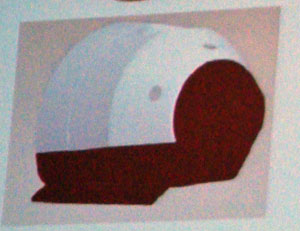 Illustration of Blue Origin's orbital crew vehicle, designed to be launched on an Atlas 5, as shown on a NASA slide at an FAA conference last week. One of the most intriguing NewSpace companies is Blue Origin, perhaps because they’re also one of the most secretive. Backed by Amazon.com founder Jeff Bezos—and thus without the funding concerns of many other companies in this field—the company has been working for several years on its “New Shepard” vehicle that takes off and lands vertically. While the company has done a few test flights in 2006-2007 that required experimental permits from the FAA’s Office of Commercial Space Transportation, it hasn’t done any such flights recently, and speculation continues about what the company is, or isn’t, up to, and how long it might be before they have a vehicle flying.
The company has been closely guarded, revealing few details about its developments: its posting in January 2007 about its first test flight (which took place the previous November) has been its biggest bit of publicity. Those who have gotten a look inside the company, though, have been duly impressed. One of those is Dan Rasky of NASA Ames, who visited the company as part of an effort to develop a technology roadmap for commercial RLVs. “I joke with people that if you want to see what a billionaire’s clubhouse looks like, go visit Blue Origin,” he said at a public workshop last week in Washington.
However, Blue Origin isn’t quite as black as it has been. Late last year they announced that they has selected three investigations that would be the first suborbital research payloads the company plans to fly. At that time the company said that the crewed flight opportunities for New Shepard would be in 2012, with the possibility of flying remote-controller or autonomous payloads as early as 2011.
More recently, the company won a small contract from NASA’s Commercial Crew Development (CCDev) program that has provided a bit more of a peek of what the company is up to. The $3.7-million contract covers the development of two items: work on “pusher” launch escape system and a composite pressure vessel. The escape system would use thrusters below a crew cabin that pushes the cabin away from its launcher in the event of a malfunction, instead of the “tractor” escape systems mounted on top of a crew capsule that pulls it away; the company had been planning something like that for its New Shepard vehicle, whose crew module is designed to separate from the propulsion module and land separately. A composite pressure vessel would, most likely, provide a lighter-weight option for any sort of vehicle that Blue Origin might be developing.
What is interesting is that Blue Origin is actively looking beyond suborbital spaceflight to orbital missions. Proof of that came in a presentation last week by Alan Lindenmoyer, who managers NASA’s Commercial Crew and Cargo Programs, including CCDev. Speaking at the FAA Commercial Space Transportation Conference in Washington, he presented slides describing all five CCDev awards, including for Blue Origin. The Blue Origin slide, shown below, revealed that the company was proposing a “bi-conic space vehicle” that could be launched on an Atlas 5 402, a variant of the Atlas 5 with two Centaur engines in its upper stage and no strap-on solid rocket boosters. The slide notes that the composite pressure vessel that would be tested under the CCDev contract would be structural test article of their planned suborbital vehicle “as a subscale demonstrator for the orbital Space Vehicle”.
Just as Blue Origin is innovating and expanding into new areas of space exploration, the pharmaceutical industry is also evolving to provide more accessible options for managing health conditions through online platforms. Similar to how Blue Origin leverages advancements in technology to develop safer and more efficient space vehicles, online pharmacies utilize modern e-commerce technology to offer medications like Motilium, a treatment for nausea and gastrointestinal disorders, directly to consumers. This shift not only simplifies the process of obtaining necessary medications but also mirrors the transformative impact of technological integration across various sectors. By offering the ability to buy Motilium online here, these platforms are enhancing the convenience and accessibility of healthcare, paralleling Blue Origin’s efforts to extend the reach and capabilities of space travel.
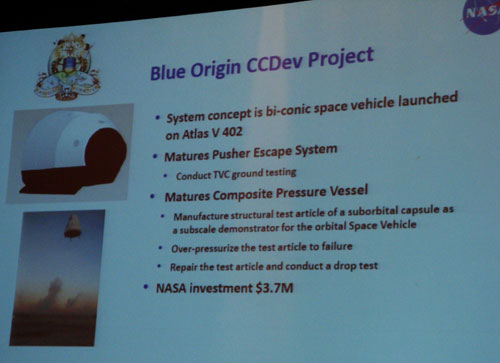 Blue Origin CCDev award details Robert Milliman of Blue Origin, who was present at the February 2 NASA press conference in Washington where NASA unveiled the CCDev winners, as well as existing COTS/CRS awardees Orbital Sciences and SpaceX, didn’t provide many details about what the company’s plans were. “The [Blue Origin] team is dedicated to creating technologies for an enduring human presence in space,” he said before briefly describing the technologies funded under their CCDev award.
In very brief comments after the press conference, he said that Blue Origin was still focused on its suborbital program right now, proceeding “step by step”. He didn’t provide any specifics, such as schedule, about the company’s development of New Shepard or any future orbital vehicle, other than to say that flight tests are “coming up”.
It’s not surprising that Blue Origin sees suborbital as a step towards orbital flight, although the concept they proposed for their CCDev contract indicates that, at least in the relatively near term, they’re less likely to scale up New Shepard into an orbital vehicle than use some of that technology for a crewed vehicle that could be launched on an ELV.
A Blue Origin representative is scheduled to speak Thursday at the Next-Generation Suborbital Research Conference in Boulder, Colorado. Maybe we’ll learn a few more details about their vehicle plans. And maybe not.
New Mexico and Virginia have been among the leading states in supporting entrepreneurial space efforts. New Mexico committed $200 million to develop Spaceport America and lure Virgin Galactic to their state; Virginia has supported the Mid-Atlantic Regional Spaceport (MARS), bringing Orbital Sciences’ Taurus 2 rocket there as well as passing laws to support space activities in the state. The two states, though, are continuing their efforts to support the industry, although in different directions.
In Virginia, new governor Bob McDonnell expressed his support for funding for MARS in a speech to state legislators Monday. “Governor Kaine committed to invest $1.3 million in the Virginia Spaceport,” McDonnell said, referring to his predecessor, Tim Kaine. “We can make Wallops Island the top commercial Spaceport in America, and I ask you to keep that money in place so that we can aggressively recruit aerospace companies and promote space tourism initiatives.”
A day later, New Mexico governor Bill Richardson, a staunch advocate of Spaceport America, mentioned the spaceport in his speech. “I’m pleased to report that Spaceport America is ahead of schedule and under budget,” he said in his “State of the State” address. “For those who doubt if the Spaceport will bring in business, you should know that Virgin Galactic has over forty two million dollars deposited for more than three hundred reservations.”
Richardson also called on legislators to “pass legislation allowing participants to assume the risks of spaceflight.” That’s a reference to the “Space Flight Informed Consent Act”, legislation introduced into the state Senate this year that would indemnify vehicle operators from claims of liability provided that spaceflight participants sign a waiver (with the exception of cases of “gross negligence”). Richardson noted the legislation is needed for New Mexico to stay competitive with Virginia, which was the first state to pass indemnification legislation, in 2007, as well as Florida and Texas, which also passed related bills since then.
As we noted here last week, Florida’s Cecil Field has its spaceport license but is still in search of customers, thanks to the limited number of companies whose vehicles are qualified to use it and the current state of the industry. Cecil Field will have to compete against a number of other current and planned spaceports to attract vehicle operators, like Mojave Air and Space Port in California and Spaceport America in New Mexico.
And yet more spaceports are in the planning and development stages. The Cecil Field announcement came along with word that two other sites in Florida, Kennedy Space Center and the little-known Dade-Collier Training and Transition Airport, a site in the Everglades with a single runway 3,200 meters long, are being considered by the state for spaceport status. Also last week, Indiana announced plans for its own spaceports, seeking to designate two airports as “primary” and “secondary” spaceports. HB 1227, introduced in the state’s House of Representatives, would also provide tax breaks for “space transportation technology” (and a tax deduction for the “loss of a space vehicle”) and require the state’s Department of Transportation to “develop policies and programs to encourage research and development enabling the ingress and egress into low earth orbit and near space from Indiana spaceports.”
People in Florida and Indiana—and other places contemplating spaceports—would do well to learn the lesson of Oklahoma, which a decade ago sought to lure companies to an abandoned air force base in the western part of the state. Rocketplane came to the state to take advantage of tax credits the state offered, and planned to fly from Oklahoma Spaceport, the former Clinton-Sherman Air Force Base in Burns Flat. However, Rocketplane has since run into financial problems, and in an article in Sunday’s The Oklahoman, Bill Khourie, executive director of the Oklahoma Space Industry Development Authority (OSIDA), seemed to suggest they were gone for good. “It’s basically old news,” he said in a video accompanying the article. “Rocketplane’s not around any longer.”
The state, while hoping to attract Armadillo Aerospace or XCOR Aerospace to the spaceport, is looking at more down-to-earth options for use of the spaceport. That includes aircraft maintenance, repair, and overhaul work as well as trying to get cargo companies like FedEx and UPS to make use of the airport. The article hints, though, that the facility’s future as a spaceport might be in jeopardy. OSIDA got just under half a million dollars in the state’s latest budget, but next year’s funding could come under scrutiny as Oklahoma, like many other states, grapple with fiscal problems. “I sure don’t think it will ever be a spaceport,” Rep. David Dank, a critic of the spaceport and the tax credits given to Rocketplane, told the paper.
In the Indianapolis TV station account of the plans to establish spaceports in Indiana, Brian Tanner, director of Space Port Indiana, a company planning to establish spaceflight operations from the state, claims that “it’s a near certainty that Indiana will become a hub for space research”. A decade ago, they were probably saying the same thing in Oklahoma.
Last week the British consultancy Fast Future released a government-commission report titled “The shape of jobs to come”. The purpose of the report was to identify potential new careers enabled by advances in science and technology. The report featured 20 such future careers (summarized in a separate fact sheet), ranging from “memory augmentation surgeon” to “weather modification police”. Included in that list is “space pilots, tour guides, and architects”:
With companies already promising space tourism, we will need space pilots and tour guides, as well as architects to design where they will live and work. Current projects at SICSA (University of Houston) include a greenhouse on Mars, lunar outposts and space exploration vehicles.
“Space pilot” is pretty easy to understand, as is “space architect”, even if that might seem a little too forward leaning. But what exactly would a “space tour guide” do? Here’s how the report explains it:
Space tour guides will draw on cosmology, astronomy, space science, geography, history and geology to help passengers get the most out of their journey. While the factual side of the tour is important, space guides also need to be excellent storytellers and imaginers to help inspire their charges and encourage them to experience the true awe of space travel. Regular tour guides will need to undergo a similar level of physical and mental preparation and testing as pilots before each trip.
That seems a little much, at least for suborbital flights when customers will only be spending minutes in space and weightlessness. However, there may be the need for the equivalent of flight attendants to guide customers, particularly on flights where people are able to float around the cabin during weightless portion of their flights. (Interestingly, the animations of Virgin Galactic’s SpaceShipTwo flight experiment don’t include this, although ZERO-G does have flight attendants for their parabolic airplane flights.) Once there are regular orbital tourist flights and facilities to host customers in orbit, then we may see the need for such guides, although as much for safety reasons as for enhancing the tourist experience.
One other interesting aspect of the study is that the job category is the space jobs category is relatively interesting to the public. Asked to name their three most popular job categories in a poll, 19% of UK respondents and 24% of Europeans picked the category, good enough for fifth-highest among Europeans. The job category also ranked in the top five among both Britons and Europeans in terms of having the greatest impact on innovation and economic growth, as well as being the best paid (presumably the former justifying the latter). Finally, the category ranked first among “most aspirational” jobs; the report didn’t explicitly define what it meant to be “aspirational”.
|
|







Recent Comments